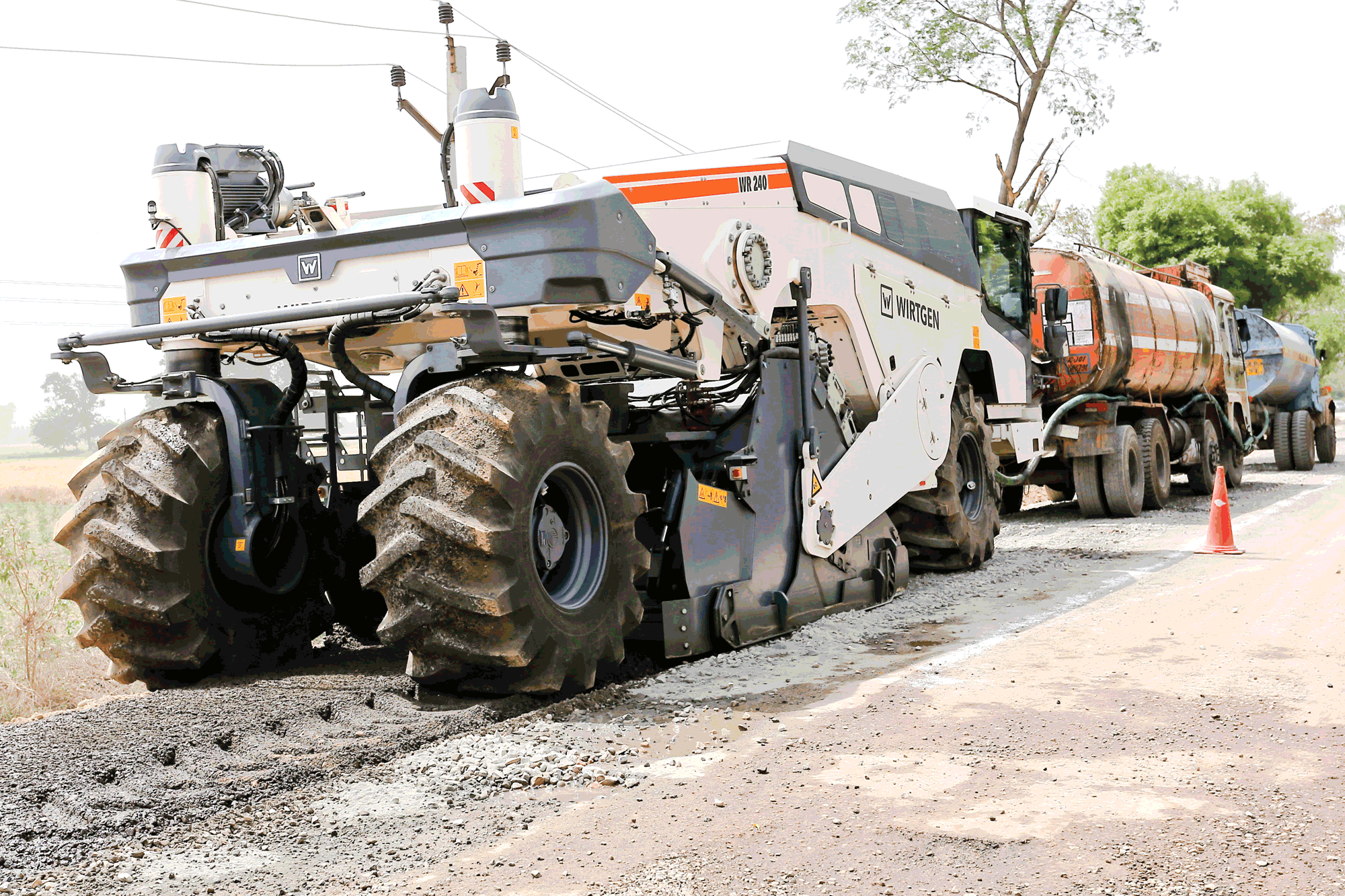WIRTGEN Cold Recycler & Soil Stabilizer WR 240: Rehabilitated 22 Km Road Near Hapur
By Edit Team | March 13, 2020 6:58 am SHARE

Low cost and high quality are two of the most important criteria when it comes to rehabilitating roads. The WIRTGEN cold recycling train has yet another advantage: roads can be reopened to traffic in no time. A WR 240 cold recycler and soil stabilizer demonstrated this advantage on a 22km-long job site near Hapur, where cars returned to the road after just 2.5 hours.
India // Hapur
The country road between Hapur and Kithore is one of the most important links in the Hapur district. It was in poor condition, with potholes, cracks and ruts, which were degrading the asphalt pavement. The decision was made to rehabilitate the road using the economical and resource saving cold recycling method. In this process, a WIRTGEN pave train mills and granulates the damaged asphalt layers, binds the material again by adding binding agent, compacts it and then directly repaves it. This is therefore referred to as an “in situ” method (performed in place). “We use all the milled material and process it specifically for this purpose, obtaining a high-quality construction material. We save a lot of time and money in this way, while minimising the environmental impact,” says Ram Kumar, Site Manager for the contractor, Seema Construction, in praise of cold recycling, a proven process worldwide that offers an excellent alternative to traditional methods. This job site alone extends over more than 22km.
Rehabilitation method proven worldwide
Another important advantage of the cold recycling method is the fast turnaround: in most cases there is no need for a complete closure of the road. This was the case in Uttar Pradesh, where traffic continued to flow in the second lane. Each rehabilitated section of the country road was reopened to traffic after just 2.5 hours, despite the fact that the cold recycling pave train does not simply pave a temporary surface, but rather a sustainably durable, high quality, cold recycled layer. Different pavement structures and combinations of machinery are possible when employing this method. At the job site near Hapur, cement was first spread on to the damaged asphalt by an SW 16 MC binding agent spreader from WIRTGEN systems partner STREUMASTER, which was followed by a tank truck that supplied the WIRTGEN WR 240 cold recycler and soil stabilizer with water. The WR 240 is equipped with the new DURAFORCE milling and mixing rotor, which thoroughly mixed the damaged layers i.e. the asphalt surface course as well as the binder and base courses together with the prespread cement and added water in a variable mixing chamber and then redeposited the material. A grader then took care of the profiling and various HAMM rollers in this case a 311 D compactor and an HD 99 tandem roller compacted the new cold recycled layer. With its new surfacing, the recycled road has a high bearing capacity and a long service life. In the final step, a conventional surface course is usually paved on top as a wearing course.
Cold recycling saves money and speeds up jobs
Many road construction companies are unaccustomed to using cement when rehabilitating bituminous asphalt layers. But adding this binding agent is standard practice in cold recycling. Together with the bitumen contained in the damaged pavement, it helps to stabilize the cold recycled layer and make it durable in the long term. Other possible binding agents include bitumen emulsion and foamed bitumen. But one material can be dispensed with in all cold recycling applications: there is no need to add newly processed aggregate. The method hence conserves resources and is very cost-effective in many respects: mix lorries do not need to be provided to transport mix to the job site, reducing fuel consumption and CO2 emissions. In addition, roads need not be blocked to traffic for extended periods and, more importantly, they need not be closed entirely. Traffic flows benefit and the cost to public budgets is reduced as well. These criteria were also deciding factors in the contract award for rehabilitation of the road between Hapur and Kithore by the cold recycling method – and the project was even completed sooner than planned. HAMM compaction technology for the final touches: the 311 D compactor and HD 99 tandem roller in operation.
Cold recycling in situ: In-place laydown of road pavements
Over time, increasing car and lorry traffic causes structural damage to the individual layers of asphalt carriage ways and compromises their load bearing capacity. As a recycler, the WR corrects these defects quickly, economically and without wasting resources, because it is equipped with a powerful DURAFORCE milling and mixing rotor as well as advanced injection systems. In a single pass, the cold recycler uses its milling and mixing rotor to remove the asphalt pavement, granulate it, inject precisely metered volumes of binding agent and water and then mix the material. The new base courses, which are paved in situ, boast a very high load bearing capacity as a result. Possible additives or binding agents include cement, water, bitumen emulsion and foamed bitumen. High precision dosing, consistently high mix quality, simple, well structured machine operation and accurate levelling guarantee optimum results. The machines in the WR series are ideally suited to applications in all performance ranges, from recycling thin asphalt layers on quiet minor roads to recycling up to 250 mm thick asphalt layers on heavily travelled motorways. The perfect addition to the WR series: the SW 16 MC binding agent spreader from WIRTGEN systems partner STREUMASTER is equipped with an electronically controlled spreading quantity control system that ensures precision application of the binding agent.
WIRTGEN DURAFORCE Milling and Mixing Rotor: A Rotor for every requirement
Cold recycling saves money and speeds up jobs demanding and varying field conditions constantly bring new challenges for cutting tools used in cold recycling and soil stabilization. For their WR series, WIRTGEN have developed a solution that is more than a match for even the most extreme requirements in both applications: the new DURAFORCE milling and mixing rotor. This development marks the end of unprofitable tool changing times, maximising lucrative operating times instead. Requirements on the milling and mixing rotor in cold recycling applications: Steady milling process to prevent oversized particles and to ensure high quality results High milling performance and low wear even in hard, abrasive material to ensure high economic efficiency Compliance with the specified grading curve to ensure the lasting structural integrity of the new base layer Homogeneous mixing of the binding agents to ensure high adhesion (bonding strength) between the individual particles and thus maximum bearing capacity.
Tried and tested forging process
The holder bases of the DURAFORCE milling and mixing rotor are given an intelligently designed 3D geometry using the tried and tested forging process. In addition to even load distribution and thus maximum stability, this process results in an optimum flow of material and homogeneous mixing of construction material. With its centrepiece, the DURAFORCE milling and mixing rotor, the WR series guarantees success in cold recycling and soil stabilization. Soil stabilization is a process for improving the load bearing capacity of soils by adding a binding agent, such as lime, cement or combinations of the two. Combined with the intelligent distribution of material, the streamlined geometry of the holding bases supports an optimal distribution of forces, particularly the peak loads generated by transverse forces. The robust edge ring segments are highly accessible and can be replaced quickly and easily.
For more information, contact:
Sales.india@wirtgen-group.com
www.wirtgen-group.com/india
Cookie Consent
We use cookies to personalize your experience. By continuing to visit this website you agree to our Terms & Conditions, Privacy Policy and Cookie Policy.


















































